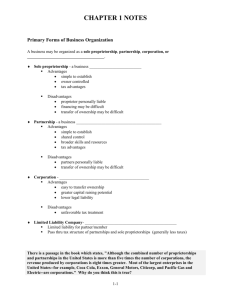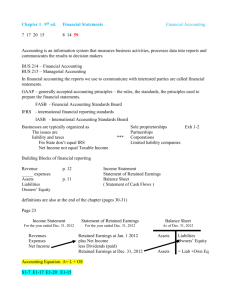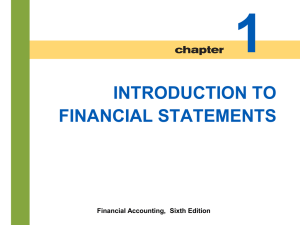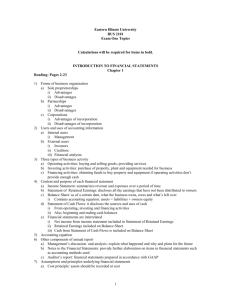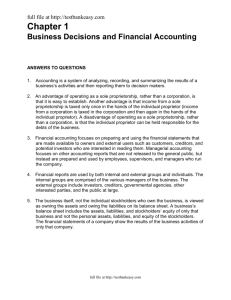Chapter 1 - Tamu.edu
advertisement
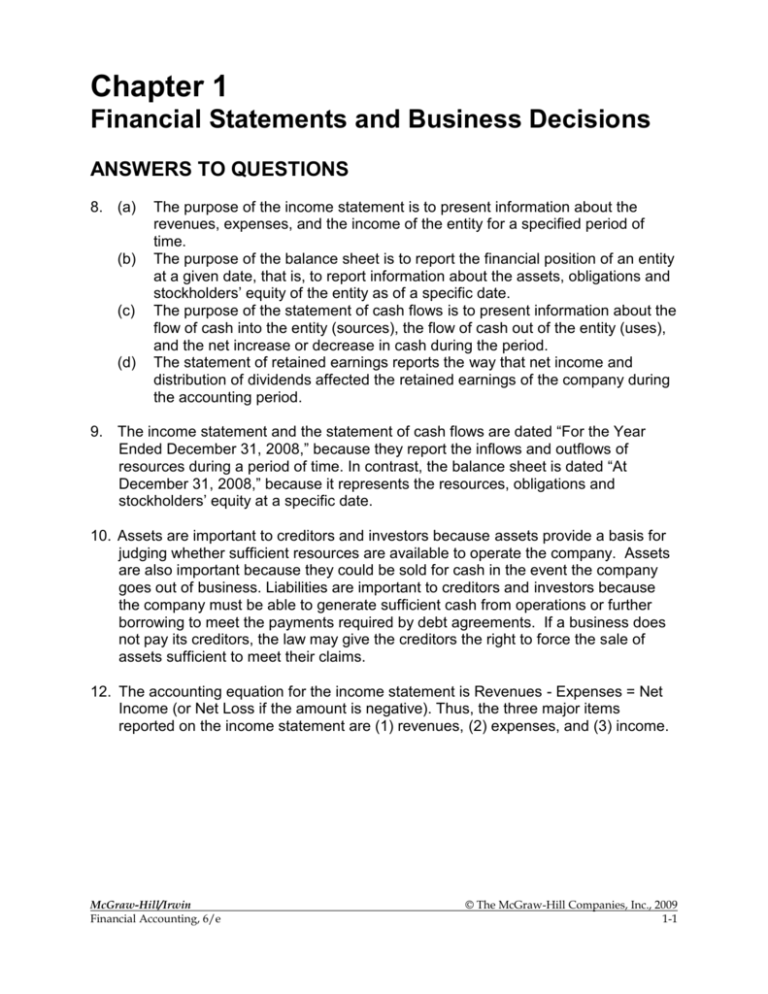
Chapter 1 Financial Statements and Business Decisions ANSWERS TO QUESTIONS 8. (a) (b) (c) (d) The purpose of the income statement is to present information about the revenues, expenses, and the income of the entity for a specified period of time. The purpose of the balance sheet is to report the financial position of an entity at a given date, that is, to report information about the assets, obligations and stockholders’ equity of the entity as of a specific date. The purpose of the statement of cash flows is to present information about the flow of cash into the entity (sources), the flow of cash out of the entity (uses), and the net increase or decrease in cash during the period. The statement of retained earnings reports the way that net income and distribution of dividends affected the retained earnings of the company during the accounting period. 9. The income statement and the statement of cash flows are dated “For the Year Ended December 31, 2008,” because they report the inflows and outflows of resources during a period of time. In contrast, the balance sheet is dated “At December 31, 2008,” because it represents the resources, obligations and stockholders’ equity at a specific date. 10. Assets are important to creditors and investors because assets provide a basis for judging whether sufficient resources are available to operate the company. Assets are also important because they could be sold for cash in the event the company goes out of business. Liabilities are important to creditors and investors because the company must be able to generate sufficient cash from operations or further borrowing to meet the payments required by debt agreements. If a business does not pay its creditors, the law may give the creditors the right to force the sale of assets sufficient to meet their claims. 12. The accounting equation for the income statement is Revenues - Expenses = Net Income (or Net Loss if the amount is negative). Thus, the three major items reported on the income statement are (1) revenues, (2) expenses, and (3) income. McGraw-Hill/Irwin Financial Accounting, 6/e © The McGraw-Hill Companies, Inc., 2009 1-1 13. The accounting equation for the balance sheet is: Assets = Liabilities + Stockholders’ Equity. Assets are the probable (expected) future economic benefits owned by the entity as a result of past transactions. They are the resources owned by the business at a given point in time such as cash, receivables, inventory, machinery, buildings, land, and patents. Liabilities are probable (expected) debts or obligations of the entity as a result of past transactions which will be paid with assets or services in the future. They are the obligations of the entity such as accounts payable, notes payable, and bonds payable. Stockholders’ equity is financing provided by owners of the business and operations. It is the claim of the owners to the assets of the business after the creditor claims have been satisfied. It may be thought of as the residual interest because it represents assets minus liabilities. 15. The accounting equation for the statement of retained earnings is: Ending Retained Earnings = Beginning Retained Earnings + Net Income - Dividends. It begins with beginning-of-the-year Retained Earnings which is the prior year’s ending retained earnings reported on the balance sheet. The current year's Net Income reported on the income statement is added and the current year's Dividends are subtracted from this amount. The ending Retained Earnings amount is reported on the end-ofperiod balance sheet. McGraw-Hill/Irwin 1-2 © The McGraw-Hill Companies, Inc., 2009 Solutions Manual EXERCISES E1–2. A A R L L SE E E E L A A L A E (1) (2) (3) (4) (5) (6) (7) (8) (9) (10) (11) (12) (13) (14) (15) Accounts receivable Cash and cash equivalents Net sales Notes payable Taxes payable Retained earnings Cost of products sold Marketing, administrative, and other operating expenses Income taxes Accounts payable Land Property, plant and equipment Long-term debt Inventories Interest expense E1–7. WALGREEN CO. Income Statement For the Quarter ended May 31, 2007 (in millions) Net sales Interest revenue Total revenues Cost of sales Selling, occupancy and administration expense Total expenses Pretax income Income tax expense Net earnings $13,698 11 $13,709 $9,821 3,022 12,843 $866 305 $561 *Note that “Provision for income taxes” is a common synonym for “Income tax expense.” McGraw-Hill/Irwin Financial Accounting, 6/e © The McGraw-Hill Companies, Inc., 2009 1-3 E1–9. Net Income (or Loss) = Revenues - Expenses Assets = Liabilities + Stockholders’ Equity A Net Income = $94,700 - $76,940 = $17,760; Stockholders’ Equity = $140,200 - $66,000 = $74,200. B Total Revenues = $84,240 + $14,740 = $98,980; Total Liabilities = $107,880 - $79,010 = $28,870. C Net Loss = $69,260 - $76,430 = ($7,170); Stockholders’ Equity = $97,850 - $69,850 = $28,000. D Total Expenses = $58,680 - $19,770 = $38,910; Total Assets = $17,890 + $78,680 = $96,570. E Net Income = $84,840 - $78,720 = $6,120; Total Assets = $20,520 + $79,580 = $100,100. McGraw-Hill/Irwin 1-4 © The McGraw-Hill Companies, Inc., 2009 Solutions Manual PROBLEMS P1–1. Req. 1 PROPANE COMPANY Income Statement For the Year Ended December 31, 2009 Total sales revenue (given) Total expenses (given) Pretax income Income tax expense ($45,800 x 30%) Net income $126,000 80,200 45,800 13,740 $ 32,060 Req. 2 PROPANE COMPANY Statement of Retained Earnings For the Year Ended December 31, 2009 Beginning retained earnings (given) +Net income (from req. 1) –Dividends (given) Ending retained earnings $ 0 32,060 12,000 $ 20,060 Req. 3 PROPANE COMPANY Balance Sheet At December 31, 2009 Assets: Cash (given) Receivables from customers (given) Inventory of merchandise (given) Equipment (given) Total assets Liabilities: Accounts payable (given) Salary payable (given) Total liabilities Stockholders' equity: Contributed capital (given) Retained earnings (from req. 2) Total stockholders' equity Total liabilities and stockholders' equity McGraw-Hill/Irwin Financial Accounting, 6/e $22,500 10,800 81,000 40,700 $155,000 $46,140 1,800 $ 47,940 $87,000 20,060 107,060 $155,000 © The McGraw-Hill Companies, Inc., 2009 1-5


